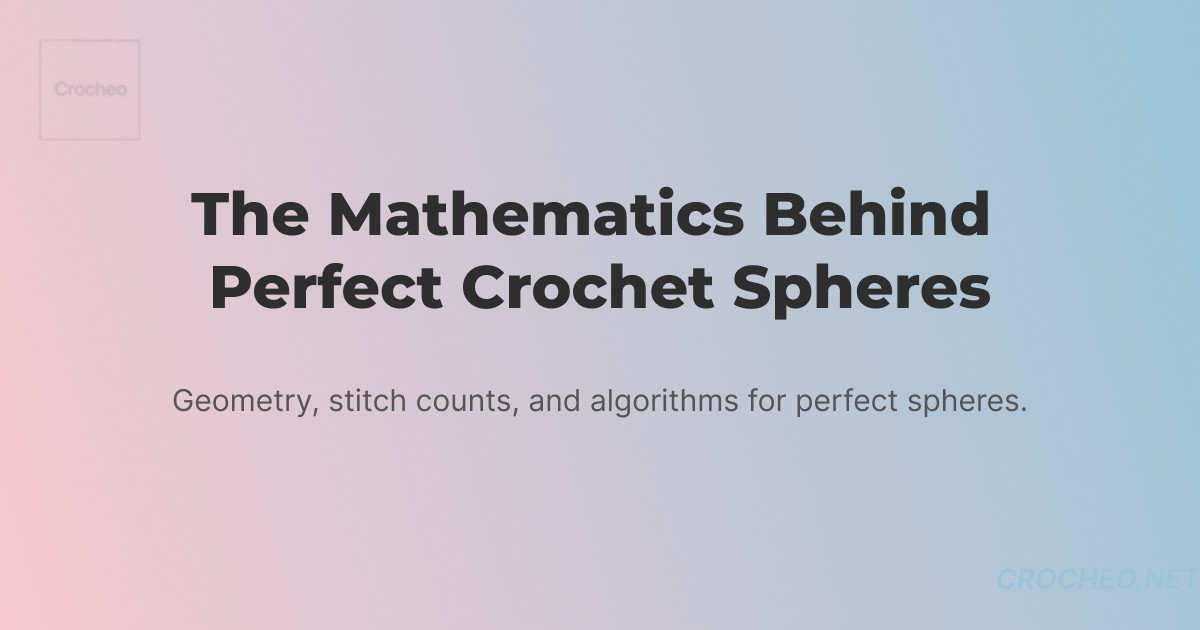The Mathematics Behind Perfect Crochet Spheres

Introduction
Crochet may look like pure art, but hidden beneath every stitch is a precise mathematical structure. Nowhere is this more evident than in the crochet sphere—the foundation for amigurumi heads, toy balls, and ornaments.
If your “ball” keeps turning into a lumpy potato, the fix is math: distribute increases and decreases so the fabric curves smoothly.
1) Geometry in Plain Terms
A sphere’s circumference at any “latitude” dictates how many stitches a round needs.
- Too few stitches → fabric cups inward.
- Too many stitches → fabric ruffles.
- Just right → a smooth curve.
We build spheres in phases:
- Increase phase → from the magic ring up to the equator.
- (Optional) straight belt → keep circumference constant for a thicker middle.
- Decrease phase → mirror the increases to close neatly.
2) The Classic 6-Increase Rule (Single Crochet)
For flat circles in single crochet (sc), you add 6 stitches per round:
- R1: MR, 6 sc → 6
- R2: inc in each → 12
- R3: (sc 1, inc) × 6 → 18
- R4: (sc 2, inc) × 6 → 24
- R5: (sc 3, inc) × 6 → 30
- …
For a sphere, increase by +6 per round until you reach your target width, then mirror with −6 per round on the way down.
Why 6? With sc, the stitch geometry approximates a hex-based tiling on the plane; +6/round keeps arc length aligned with growing circumference.
3) Sizing: From Diameter to Rounds
Let:
d= target diameter (cm)st_per_cm= your gauge (stitches per cm) measured around a roundr = d / 2
A simple, practical plan:
- Max round stitch count ≈
circumference × st_per_cm - Circumference ≈
π × d
Then the number of increase rounds is roughly: rounds_up ≈ (max_stitches / 6) Mirror for decreases.
4) Real-World Adjustments
- Yarn & hook: Thicker yarn or larger hook → fewer rounds to reach the same size.
- Tension: Tighter tension → more stitches per cm → more rounds.
- Stitch type: hdc/dc have taller stitches and change the curve; the +6 rule is sc-specific.
5) Quick Generator (JavaScript)
Use this small helper to sketch a stitch-count plan:
function spherePlan(diameterCm, stitchesPerCm) {
const maxStitches = Math.round(Math.PI * diameterCm * stitchesPerCm);
const roundsUp = Math.max(1, Math.round(maxStitches / 6));
const up = Array.from({ length: roundsUp }, (_, i) => 6 * (i + 1));
const down = up.slice(0, -1).reverse();
return [...up, ...down];
}
// Example: 10 cm ball, 4 stitches per cm
console.log(spherePlan(10, 4));
// -> e.g., [6,12,18,24,30,36,42,48,54,60,54,48,42,36,30,24,18,12,6]
Use the output as your per-round stitch counts. If you want a belt (constant circumference), repeat the max count for a few rounds before decreasing.
6) Example Pattern (Small Sphere, sc)
Gauge (example): ~4 sts/cm in the round
Target: ~6–7 cm diameter (adjust as needed)
R1: MR, 6 sc [6]
R2: inc in each [12]
R3: (sc 1, inc) × 6 [18]
R4: (sc 2, inc) × 6 [24]
R5: (sc 3, inc) × 6 [30]
R6: (sc 4, inc) × 6 [36]
R7: (sc 5, inc) × 6 [42]
R8: (sc 6, inc) × 6 [48]
(Optional belt)
R9–R10: sc around [48]
R11: (sc 6, dec) × 6 [42]
R12: (sc 5, dec) × 6 [36]
R13: (sc 4, dec) × 6 [30]
R14: (sc 3, dec) × 6 [24]
R15: (sc 2, dec) × 6 [18]
R16: (sc 1, dec) × 6 [12]
R17: dec in each [6]
Fasten off, weave ends.Wrap-Up
Perfect crochet spheres aren’t luck—they’re controlled increases that match a growing circumference, then a mirror decrease to close. Once you know your gauge, you can generate stitch counts for any size ball, every time.
Next up: extending this math to ellipsoids and stylized amigurumi heads (different growth rates on different axes).
Written by Crocheo — combining crochet artistry with coding precision.